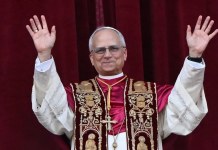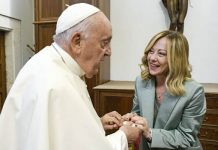
A secret meeting called a conclave elects the Catholic leader.
The Catholic religion has more than 1 billion followers around the world, and the pope leads them all. The pope is the leader ofthe Catholic Church and the head of state for Vatican City, which is the world’s smallest country. There have been more than260 popes spread across the roughly 2,000 years of Catholic history, and most of them serve in the job until the end of theirlives. When a pope dies or resigns, a new one must be selected.
That is when it’s time to call a conclave.
A conclave is a secret meeting, but the secret’s out for some traditions of a Catholic conclave. The event has stayed prettymuch the same for hundreds of years. It usually starts 15 to 20 days after a pope dies or steps down. Top leaders in the Catholic Church — called cardinals — travel to the Vatican, where they get shut inside away from the influences of the outside world. These cardinals vote for the next pope.
A conclave will soon begin following the death of Pope Francis on April 21. There are currently 135 cardinals who can vote. Arule says the voters must all be under 80 years old. The cardinals are coming from all across the planet. Italy has the mosteligible cardinals at 17, and they don’t have far to go. That’s because Vatican City is completely surrounded by Rome, Italy!
The United States has 10 cardinals who could vote, Brazil has seven, and Spain and France have five each. Canada, India, Poland, and Argentina each have four. This year’s vote could be especially difficult to predict because the group of cardinals is much more diverse than in the past. During his time in charge, Pope Francis named many more cardinals, often in places that were underrepresented, such as Africa, Asia, and South America. Some countries got a cardinal for the first time ever. They include Rwanda in Africa, Tonga in the South Pacific, and Mongolia in Asia.
Once the voting cardinals arrive, the conclave begins. To start off, the cardinals — who wear red robes — take part in a Catholic Mass. Then, they head to the Sistine Chapel and take an oath of secrecy. The cardinals promise to keep their votes secret and not to have any contact with the outside world during the conclave. That means no phones, newspapers, or internet. These rules are meant to make sure no people from outside the group can sway the voting.
On the first day of conclave, there is one vote. The cardinals put their picks on pieces of paper and count them, passing a needle through each ballot to string them together. Under the official rules, any Catholic man could be pope, but, unofficially, the pick is almost always a cardinal. A man needs two-thirds of the votes to win. If that mark isn’t reached, the voting continues with two rounds of voting each morning and two each afternoon until there is a winner. This process goes on for as long as is needed. It usually concludes in a matter of days, but it can also last for months or even years!
The cardinals have a special way of reporting their voting results to the world. After a vote, they burn the ballots in a stove with special chemicals to change the color of the smoke. If black smoke rises from the Sistine Chapel’s chimney, that means no pope was elected, but if white smoke comes out, the Catholic Church has a new leader! Many people gather outside in St. Peter’s Square and look up, waiting for the smoke.
After a successful vote, the winner is asked two questions. First, he is asked if he will accept the job, and second, he is asked to choose the name he will use as pope. Almost all popes change their name. The most popular pick is John, followed by Benedict and Gregory.
Who will be named the next leader of the Catholic Church?
By Ashley Morgan
Updated April 23, 2025, 5:00 P.M. (ET)
This article is reprinted from News-o-Matic—Catholic Content for Kids. For subscription information, please visit https://www.gospelweeklies.com/a-new-partnership-catholic-content-for-kids-on-news-o-matic/




